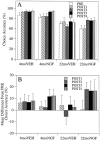The effects of nerve growth factor on spatial recent memory in aged rats persist after discontinuation of treatment
- PMID: 9065514
- PMCID: PMC6573502
- DOI: 10.1523/JNEUROSCI.17-07-02543.1997
The effects of nerve growth factor on spatial recent memory in aged rats persist after discontinuation of treatment
Abstract
Nerve growth factor (NGF) infusion significantly reduces spatial recent memory deficits in aged rats, an effect that has great relevance to the treatment of memory impairments characteristic of patients with Alzheimer's disease. The present study was designed to examine whether this NGF-induced improvement in spatial recent memory persists after the discontinuation of NGF treatment, an issue of crucial importance for the potential clinical use of this compound. Spatial recent memory was tested in a Morris water maze delayed nonmatch-to-position task. In addition to memory, sensorimotor skills were also examined. Four- and 22-month-old rats were tested preoperatively, infused intraventricularly with recombinant human NGF or vehicle, and tested both during the 4 week infusion period and during the 4 weeks after discontinuation of the infusion. NGF significantly improved spatial recent memory in 22-month-old rats only, during the 4th week of infusion and for up to 4 weeks after discontinuation of the infusion. Although NGF did not affect overall sensorimotor skills during infusion in either age group, sensorimotor skills were significantly improved both 2 and 4 weeks after discontinuation of infusion in 22-month-old rats. These findings demonstrate that the beneficial effects of NGF on spatial recent memory can persist for up to 1 month after discontinuation of infusion and suggest that NGF can be used intermittently for the treatment of age-associated memory dysfunction and Alzheimer's disease.
Figures






Similar articles
-
Selective effects of nerve growth factor on spatial recent memory as assessed by a delayed nonmatching-to-position task in the water maze.J Neurosci. 1996 May 15;16(10):3541-8. doi: 10.1523/JNEUROSCI.16-10-03541.1996. J Neurosci. 1996. PMID: 8627387 Free PMC article.
-
Human nerve growth factor improves spatial memory in aged but not in young rats.J Neurosci. 1994 Aug;14(8):4815-24. doi: 10.1523/JNEUROSCI.14-08-04815.1994. J Neurosci. 1994. PMID: 8046452 Free PMC article.
-
NGF improves spatial memory in aged rodents as a function of age.J Neurosci. 1991 Jul;11(7):1889-906. doi: 10.1523/JNEUROSCI.11-07-01889.1991. J Neurosci. 1991. PMID: 1648601 Free PMC article.
-
Nerve growth factor reverses spatial memory impairments in aged rats.Neurochem Int. 1994 Jul;25(1):47-52. doi: 10.1016/0197-0186(94)90052-3. Neurochem Int. 1994. PMID: 7950969
-
The effects of intrahippocampal BDNF and NGF on spatial learning in aged Long Evans rats.Mol Chem Neuropathol. 1996 Oct-Dec;29(2-3):211-26. doi: 10.1007/BF02815003. Mol Chem Neuropathol. 1996. PMID: 8971697
Cited by
-
Long-lasting rescue of age-associated deficits in cognition and the CNS cholinergic phenotype by a partial agonist peptidomimetic ligand of TrkA.J Neurosci. 2004 Sep 15;24(37):8009-18. doi: 10.1523/JNEUROSCI.1508-04.2004. J Neurosci. 2004. PMID: 15371501 Free PMC article.
-
Exercise leads to the re-emergence of the cholinergic/nestin neuronal phenotype within the medial septum/diagonal band and subsequent rescue of both hippocampal ACh efflux and spatial behavior.Exp Neurol. 2016 Apr;278:62-75. doi: 10.1016/j.expneurol.2016.01.018. Epub 2016 Jan 30. Exp Neurol. 2016. PMID: 26836322 Free PMC article.
-
Spatial navigation in complex and radial mazes in APP23 animals and neurotrophin signaling as a biological marker of early impairment.Learn Mem. 2006 Jan-Feb;13(1):63-71. doi: 10.1101/lm.2606. Epub 2006 Jan 17. Learn Mem. 2006. PMID: 16418433 Free PMC article.
-
Timing of cyclic estradiol treatment differentially affects cognition in aged female rhesus monkeys.Behav Neurosci. 2018 Aug;132(4):213-223. doi: 10.1037/bne0000259. Epub 2018 Jun 28. Behav Neurosci. 2018. PMID: 29952604 Free PMC article.
-
Ex vivo nerve growth factor gene transfer to the basal forebrain in presymptomatic middle-aged rats prevents the development of cholinergic neuron atrophy and cognitive impairment during aging.Proc Natl Acad Sci U S A. 1998 Feb 17;95(4):1858-63. doi: 10.1073/pnas.95.4.1858. Proc Natl Acad Sci U S A. 1998. PMID: 9465107 Free PMC article.
References
-
- Bartus RT, Dean RL, Pontecorvo MJ, Flicker C. The cholinergic hypothesis: a historical overview, current perspectives, and future directions. Ann NY Acad Sci. 1985;444:332–358. - PubMed
-
- Bondi MW, Salmon DP, Butters N. Neuropsychological features of memory disorders in Alzheimer’s disease. In: Terry RD, Katzman R, Bick KL, editors. Alzheimer’s disease. Raven; New York: 1994.
-
- Craik FIM. Age differences in human memory. In: Birren JE, Schaie KW, editors. Handbook of the psychology of aging. Van Nostrand Reinhold; New York: 1977. pp. 384–420.
-
- Damasio AR, Eslinger PJ, Damasio H, Van Hoesen GW, Cornell S. Multimodal amnesiac syndrome following bilateral temporal and basal forebrain damage. Arch Neurol. 1985;42:252–259. - PubMed
-
- deToledo-Morrell L, Morrell F, Fleming S. Age related deficits in spatial memory and hippocampal plasticity. Behav Neurosci. 1984;98:902–907. - PubMed
Publication types
MeSH terms
Substances
Grants and funding
LinkOut - more resources
Full Text Sources
Medical
